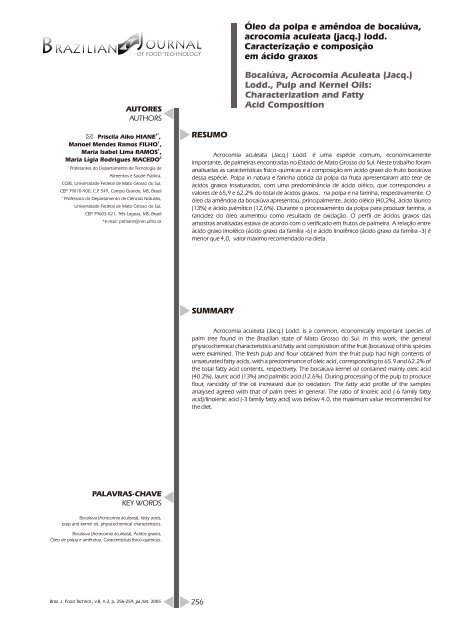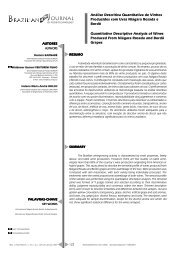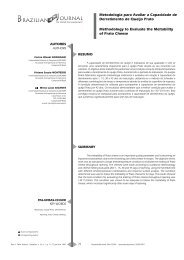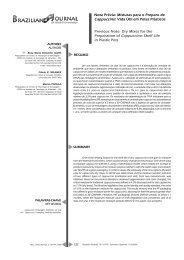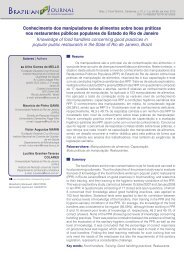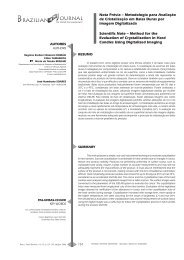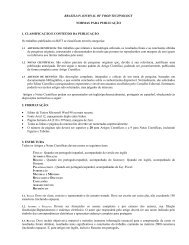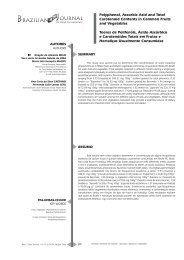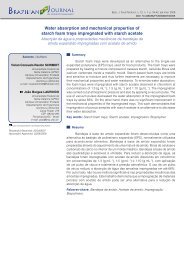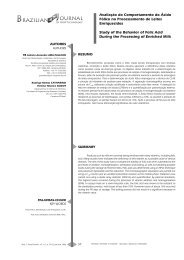Bocaiúva, Acrocomia Aculeata (Jacq.) - Brazilian Journal of Food ...
Bocaiúva, Acrocomia Aculeata (Jacq.) - Brazilian Journal of Food ...
Bocaiúva, Acrocomia Aculeata (Jacq.) - Brazilian Journal of Food ...
Create successful ePaper yourself
Turn your PDF publications into a flip-book with our unique Google optimized e-Paper software.
OF FOOD TECHNOLOGY<br />
AUTORES<br />
AUTHORS<br />
Óleo da polpa e amêndoa de bocaiúva,<br />
acrocomia aculeata (jacq.) lodd.<br />
Caracterização e composição<br />
em ácido graxos<br />
Bocaiúva, <strong>Acrocomia</strong> <strong>Aculeata</strong> (<strong>Jacq</strong>.)<br />
Lodd., Pulp and Kernel Oils:<br />
Characterization and Fatty<br />
Acid Composition<br />
Priscila Aiko HIANE ,<br />
1<br />
Manoel Mendes Ramos FILHO ,<br />
1<br />
Maria Isabel Lima RAMOS ,<br />
2<br />
Maria Lígia Rodrigues MACEDO<br />
1<br />
Pr<strong>of</strong>essores do Departamento de Tecnologia de<br />
Alimentos e Saúde Pública,<br />
CCBS, Universidade Federal de Mato Grosso do Sul,<br />
CEP 79070-900, C.P. 549, Campo Grande, MS, Brazil<br />
2<br />
Pr<strong>of</strong>essora do Departamento de Ciências Naturais,<br />
Universidade Federal de Mato Grosso do Sul,<br />
CEP 79603-021, Três Lagoas, MS, Brazil<br />
*e-mail: prihiane@nin.ufms.br<br />
1*<br />
RESUMO<br />
<strong>Acrocomia</strong> aculeata (<strong>Jacq</strong>.) Lodd. é uma espécie comum, economicamente<br />
importante, de palmeiras encontradas no Estado de Mato Grosso do Sul. Neste trabalho foram<br />
analisadas as características físico-químicas e a composição em ácido graxo do fruto bocaiúva<br />
dessa espécie. Polpa in natura e farinha obtida da polpa da fruta apresentaram alto teor de<br />
ácidos graxos insaturados, com uma predominância de ácido oléico, que correspondeu a<br />
valores de 65,9 e 62,2% do total de ácidos graxos, na polpa e na farinha, respectivamente. O<br />
óleo da amêndoa da bocaiúva apresentou, principalmente, ácido oléico (40,2%), ácido láurico<br />
(13%) e ácido palmítico (12,6%). Durante o processamento da polpa para produzir farinha, a<br />
rancidez do óleo aumentou como resultado de oxidação. O perfil de ácidos graxos das<br />
amostras analisadas estava de acordo com o verificado em frutos de palmeira. A relação entre<br />
ácido graxo linoléico (ácido graxo da família -6) e ácido linolênico (ácido graxo da família -3) é<br />
menor que 4,0, valor máximo recomendado na dieta.<br />
SUMMARY<br />
<strong>Acrocomia</strong> aculeata (<strong>Jacq</strong>.) Lodd. is a common, economically important species <strong>of</strong><br />
palm tree found in the <strong>Brazilian</strong> state <strong>of</strong> Mato Grosso do Sul. In this work, the general<br />
physicochemical characteristics and fatty acid composition <strong>of</strong> the fruit (bocaiúva) <strong>of</strong> this species<br />
were examined. The fresh pulp and flour obtained from the fruit pulp had high contents <strong>of</strong><br />
unsaturated fatty acids, with a predominance <strong>of</strong> oleic acid, corresponding to 65.9 and 62.2% <strong>of</strong><br />
the total fatty acid contents, respectively. The bocaiúva kernel oil contained mainly oleic acid<br />
(40.2%), lauric acid (13%) and palmitic acid (12.6%). During processing <strong>of</strong> the pulp to produce<br />
flour, rancidity <strong>of</strong> the oil increased due to oxidation. The fatty acid pr<strong>of</strong>ile <strong>of</strong> the samples<br />
analysed agreed with that <strong>of</strong> palm trees in general. The ratio <strong>of</strong> linoleic acid (-6 family fatty<br />
acid)/linolenic acid (-3 family fatty acid) was below 4.0, the maximum value recommended for<br />
the diet.<br />
PALAVRAS-CHAVE<br />
KEY WORDS<br />
Bocaiúva (<strong>Acrocomia</strong> aculeata), fatty acids,<br />
pulp and kernel oil, physicochemical characteristics.<br />
Bocaiúva (<strong>Acrocomia</strong> aculeata), Ácidos graxos,<br />
Óleo de polpa e amêndoa, Características físico-químicas.<br />
Braz. J. <strong>Food</strong> Technol., v.8, n.3, p. 256-259, jul./set. 2005<br />
256
OF FOOD TECHNOLOGY<br />
HIANE, P. A.; RAMOS FILHO, M. M. ;<br />
RAMOS, M. I. L. & MACEDO, M. L. R.<br />
Óleo da polpa e amêndoa de bocaiúva,<br />
acrocomia aculeata (jacq.) lodd.<br />
Caracterização e composição<br />
em ácido graxos<br />
1. INTRODUCTION<br />
Bocaiúva is the popular name for fruit from the palm tree<br />
<strong>Acrocomia</strong> aculeata (<strong>Jacq</strong>.) Lodd., family Palmae which is<br />
abundant in the <strong>Brazilian</strong> state <strong>of</strong> Mato Grosso do Sul. Other<br />
species <strong>of</strong> this genus also occur in this state and also in southeastern<br />
Brazil and Central America, and they are known by<br />
common names such as macaúba, catarro coconut, macabira,<br />
mocajuba and macaíba (SILVA et al., 1994). Following<br />
maturation, the oily, semi-fibrous, mucilaginous pulp <strong>of</strong><br />
bocaiúva is edible and has a characteristic sweet flavour (POTT<br />
& POTT, 1994; ALMEIDA, 1998). The seed (kernel) <strong>of</strong> the fruit<br />
can be eaten raw or in the form <strong>of</strong> candies, known as "paçoca"<br />
and "cocada" (SILVA et al.,1994; ALMEIDA, 1998).<br />
The bocaiúva pulp contains yellowy red oil that can<br />
be used to produce cooking oil. The kernel also contains<br />
transparent oil that can be purified for use in cooking and the<br />
production <strong>of</strong> sweets (MACAÚBA, 1986). Oils and fats are<br />
important sources <strong>of</strong> energy for human metabolism. The effects<br />
<strong>of</strong> dietary lipids on growth and tissue fatty acid composition<br />
have been extensively investigated (SENANAYAKE & SHAHIDI,<br />
2002; LAPOSATA et al., 2002; PARK et al., 1999; STANTON et<br />
al., 1997). The involvement <strong>of</strong> saturated fatty acids in heart<br />
disease has led to the exclusion <strong>of</strong> fats from the diet (KEONG et<br />
al., 2003; GRISDALE-HELLAND et al., 2002). Flour prepared<br />
from the pulp <strong>of</strong> mature bocaiúva (<strong>Acrocomia</strong> mokayáyba Barb.<br />
Rodr.) has high vitamin A and oil contents (HIANE &<br />
PENTEADO, 1989; HIANE et al., 1990). This composition has<br />
led to interest in this fruit as a source <strong>of</strong> raw material for food<br />
products. It is possible that the good storage properties <strong>of</strong> the<br />
whole fruit with its hard peel, being more protected against<br />
photochemical reactions (FENNEMA, 1985), could allow for<br />
the flour to be produced out <strong>of</strong> season.<br />
AMAYA-FARFÁN et al. (1986) and HIANE et al. (1990),<br />
investigating other bocaiúva species, respectively <strong>Acrocomia</strong><br />
sclerocarpa Mart. and A. mokayáyba (Barb.) Rodr., from the<br />
<strong>Brazilian</strong> north-eastern and central west areas, showed that the<br />
oil <strong>of</strong> the fruit pulp contained principally oleic acid followed by<br />
palmitic acid; and in the oil <strong>of</strong> the kernel, AMAYA-FARFÁN et al.<br />
(1986) found lauric and oleic acids as the predominant fatty acids.<br />
In this work the general physicochemical<br />
characteristics and fatty acid composition <strong>of</strong> the fruit (bocaiúva)<br />
<strong>of</strong> the species <strong>Acrocomia</strong> aculeata (<strong>Jacq</strong>.) Lodd., from the<br />
<strong>Brazilian</strong> state <strong>of</strong> Mato Grosso do Sul, were examined, as well as<br />
verifying changes in the characteristics <strong>of</strong> the fruit pulp oil<br />
during processing to produce flour.<br />
2. METHODOLOGY<br />
[autor foi “pulp” ou “flour”].<br />
The oil in the fresh pulp, pulp flour and kernels was<br />
extracted by the Bligh & Dyer method, as described by KATES<br />
(1972), in order to determine its physicochemical properties<br />
and fatty acid composition.<br />
2.2. Methods<br />
2.2.1. Oil content<br />
The oil content was determined by direct extraction in<br />
a Soxhlet apparatus, using petroleum ether (boiling point 40-<br />
60oC), according to standard procedures (INSTITUTO ADOLFO<br />
LUTS, 1985).<br />
2.2.2. Physicochemical characteristics<br />
The physicochemical characteristics <strong>of</strong> the fresh pulp,<br />
pulp and kernel oils were determined by standard procedures<br />
recommended by THE INSTITUTO ADOLFO LUTZ (1985) and<br />
the AMERICAN OIL CHEMISTS' SOCIETY - AOCS (1998).<br />
For acidity, an aliquot <strong>of</strong> oil was weighed, dissolved in<br />
ethyl ether:ethanol (2:1, v/v) and titrated with 0.1mol/L sodium<br />
hydroxide. The iodine content was determined by the method<br />
<strong>of</strong> Wijs, using Wijs solution and 0.1mol/L sodium thiosulphate.<br />
The refractive indices <strong>of</strong> the pulp and kernel oils were<br />
determined in an Abbé refractometer. The saponification value<br />
was determined by saponification with 4% potassium<br />
hydroxide and titration with 0.5N HCl. The peroxide content <strong>of</strong><br />
the oil was determined according to the AOCS method.<br />
2.2.3. Fatty acid composition<br />
After extraction, the oils were saponified and the fatty<br />
acids converted to methyl esters as described by HARTMAN &<br />
LAGO (1973).<br />
The fatty acid methyl esters were analysed, using a<br />
model Star 3400 Varian Gas Chromatograph, equipped with a<br />
flame ionisation detector, a split/splitless injector and a capillary<br />
column <strong>of</strong> melted silica (30 m x 0.25 mm, J & Scientific, USA),<br />
containing polyethylene glycol (D B Wax) as the stationary<br />
phase. The chromatographic conditions used included:<br />
detector temperature <strong>of</strong> 260ºC, injector temperature <strong>of</strong> 250ºC,<br />
column temperature <strong>of</strong> 200ºC for 20 min, programmed for 1ºC<br />
per minute up to 220ºC, hydrogen gas with flow rates <strong>of</strong><br />
1.1mL/min., make-up gas <strong>of</strong> nitrogen for 22mL/min.<br />
The fatty acids were identified by comparing the<br />
retention times <strong>of</strong> the sample peaks with those <strong>of</strong> methyl ester<br />
standards <strong>of</strong> the fatty acids. The areas <strong>of</strong> the peaks were<br />
calculated and expressed as a percentage <strong>of</strong> the total area.<br />
2.1 Material<br />
Bocaiúva, <strong>Acrocomia</strong> aculeata (<strong>Jacq</strong>) Lodd., fruits<br />
were collected on the campus <strong>of</strong> the Federal University <strong>of</strong> Mato<br />
Grosso do Sul. For analysis, the fresh fruits (1kg) were shelled<br />
and the pulp and kernels removed and ground. A portion <strong>of</strong> the<br />
homogenized pulp was dehydrated in a forced ventilation oven<br />
at 40-50°C for 4h and then blended and sifted to obtain pulp<br />
3. RESULTS AND DISCUSSION<br />
3.1 Oil content and physicochemical characteristics<br />
Table 1 shows that the fresh pulp, flour and kernels <strong>of</strong><br />
bocaiúva were rich in oils with values <strong>of</strong> 16.5, 19.3 and 52.9%<br />
(on a wet basis), respectively.<br />
Braz. J. <strong>Food</strong> Technol., v.8, n.3, p. 256-259, jul./set. 2005<br />
257
OF FOOD TECHNOLOGY<br />
HIANE, P. A.; RAMOS FILHO, M. M.;<br />
RAMOS, M. I. L. & MACEDO, M. L. R.<br />
Óleo da polpa e amêndoa de bocaiúva,<br />
acrocomia aculeata (jacq.) lodd.<br />
Caracterização e composição<br />
em ácido graxos<br />
The acidity and peroxide content <strong>of</strong> the pulp flour<br />
were higher than those <strong>of</strong> the fresh pulp, indicating that the<br />
processing <strong>of</strong> bocaiúva pulp at 40 to 50°C to obtain flour led to<br />
the breakdown <strong>of</strong> glycerides with the release <strong>of</strong> free fatty acids<br />
and oxidation <strong>of</strong> the oil. Despite these higher values, the flavour<br />
<strong>of</strong> the product was unaltered, since fresh pulp contains lipolytic<br />
enzymes that hydrolyse the oil soon after maturation <strong>of</strong> the<br />
fruit, thereby releasing low molecular weight fatty acids and<br />
glycerol that give the fruit its characteristic flavour (MACAÚBA,<br />
1986; LAGO et al., 1991).<br />
Compared to oils from other palm tree fruits, the<br />
bocaiúva pulp and kernel oils showed lower acidity values than<br />
those found in buriti, palm and palmiste oils (TAVARES et al.,<br />
1990; SERRUYA et al., 1980); and these values were also low in<br />
comparison to the maximum allowable acidity for raw or virgin<br />
edible oils, such as olive and palm oils (maximum <strong>of</strong> 5.0%)<br />
(BRASIL, 1999).<br />
The saponification values agreed with those<br />
commonly found for the edible and refined oils (usual range:<br />
181-265) (BRASIL, 1999), and the iodine content was higher<br />
than reported for the pulp and kernel <strong>of</strong> palm oil (BRASIL, 1999;<br />
TAVARES et al., 1990).<br />
3.2 Fatty acid composition<br />
Table 2 shows the fatty acid compositions <strong>of</strong> bocaiúva<br />
pulp, pulp flour and kernel oil. In the pulp and pulp flour, there<br />
was a predominance <strong>of</strong> oleic acid, with levels similar to those<br />
found in the fruit <strong>of</strong> other palm trees (LAGO et al., 1991;<br />
SERRUYA et al., 1980; TRUJILLO-QUIJANO et al., 1992;<br />
AMAYA-FARFÁN et al., 1986; SOUZA et al., 1986; MESQUITA et<br />
al., 2001), palmitic acid being the second most abundant fatty<br />
acid, in agreement with previous reports (HIANE et al., 1990;<br />
AMAYA-FARFÁN et al., 1986). Oleic acid was the predominant<br />
fatty acid in the bocaiúva kernel, followed by lauric acid, whilst<br />
lauric acid was the predominant fatty acid in the kernel oil <strong>of</strong><br />
other previously reported bocaiúva species (AMAYA-FARFÁN et<br />
al., 1986).<br />
The fresh pulp and pulp flour showed similar contents<br />
<strong>of</strong> monounsaturated fatty acids (66.9 and 66.4%, respectively)<br />
to those verified in edible oils rich in these fatty acids, such as<br />
olive (56-87%), peanut (15-47%) and canola oil (54-75%)<br />
(BRASIL,1999).<br />
In the fruit kernel, 42.5% <strong>of</strong> monounsaturated fatty<br />
acids and a high value <strong>of</strong> saturated acids (49.7%) were<br />
observed. Other palm kernel oils, such as palmiste oil (Elaeis<br />
guineensis <strong>Jacq</strong>.), presented lower monounsaturated (12-19%)<br />
and higher saturated (69-98%) acid values than those verified in<br />
the kernel studied here (BRASIL, 1999).<br />
With respect to the -3 family <strong>of</strong> fatty acids, the<br />
linolenic acid values for bocaiúva pulp, pulp flour and kernel<br />
(respectively, 2.5; 2.7 and 1.9%) were high when compared to<br />
the values for olive (0.5%), sunflower (1%), corn (1%) and palm<br />
oils (1%) (BELDA & POURCHET-CAMPOS, 1991). The data<br />
found were above the recommended dietary intake for the<br />
adult man (THE NATIONAL ACADEMIES PRESS, 2002).<br />
TABLE 1 Physicochemical characteristics <strong>of</strong> the in natura pulp,<br />
pulp flour and kernel oil <strong>of</strong> bocaiúva, <strong>Acrocomia</strong> aculeata<br />
(<strong>Jacq</strong>.) Lodd., from the state <strong>of</strong> Mato Grosso do Sul.<br />
Acidity, in oleic acid (%, w/w)<br />
Iodine (WIJS)<br />
CHARACTERISTICS<br />
Saponification index (mg KOH/g oil)<br />
Refractive index at 40°C<br />
Peroxide value (mEq/kg oil)<br />
Oil content (g/100 g on a wet basis)<br />
PULP<br />
0.83<br />
75.43<br />
210.50<br />
1.4609<br />
2.09<br />
16.50<br />
PULP<br />
FLOUR<br />
3.14<br />
74.04<br />
206.30<br />
1.4615<br />
5.80<br />
19.30<br />
KERNEL<br />
0.21<br />
54.05<br />
258.00<br />
1.4539<br />
0.00<br />
52.90<br />
TABLE 2 Oil fatty acid composition (%) <strong>of</strong> the in natura pulp,<br />
pulp flour and kernel <strong>of</strong> the bocaiúva, <strong>Acrocomia</strong> aculeata<br />
(<strong>Jacq</strong>.) Lodd. from the state <strong>of</strong> Mato Grosso do Sul.<br />
FATTY ACID<br />
Capryllic acid (C8)<br />
Capric acid (C10)<br />
Lauric acid (C12)<br />
Myristic acid (C14)<br />
Palmitic acid (C16)<br />
Palmitoleic acid (C16:1)<br />
Stearic acid (C18)<br />
Oleic acid (C18:1)<br />
Linoleic acid (C18:2)<br />
Linolenic acid (C18:3)<br />
Araquidic acid (C20)<br />
% SFA<br />
% MUFA<br />
% PUFA<br />
MUFA/SFA<br />
PUFA/SFA<br />
SFA= Saturated fatty acids<br />
MUFA= Monounsaturated fatty acids<br />
PUFA= Polyunsaturated fatty acids<br />
4. CONCLUSIONS<br />
PULP<br />
0.45<br />
0.27<br />
1.97<br />
0.45<br />
15.96<br />
1.01<br />
5.92<br />
65.87<br />
5.10<br />
2.52<br />
0.50<br />
25.52<br />
66.88<br />
7.62<br />
2.62<br />
0.30<br />
PULP<br />
FLOUR<br />
0.41<br />
0.23<br />
1.98<br />
0.42<br />
18.53<br />
4.19<br />
4.88<br />
62.16<br />
4.03<br />
2.74<br />
0.53<br />
26.98<br />
66.35<br />
6.77<br />
2.46<br />
0.25<br />
KERNEL<br />
5.96<br />
1.79<br />
12.95<br />
9.49<br />
12.62<br />
2.29<br />
6.58<br />
40.17<br />
5.91<br />
1.92<br />
0.30<br />
49.69<br />
42.46<br />
7.83<br />
0.82<br />
0.15<br />
The results obtained show that the pulp, flour and<br />
kernels <strong>of</strong> the bocaiúva presented pr<strong>of</strong>iles similar to those <strong>of</strong><br />
other palm tree fruits with respect to the physicochemical<br />
Braz. J. <strong>Food</strong> Technol., v.8, n.3, p. 256-259, jul./set. 2005<br />
258
OF FOOD TECHNOLOGY<br />
HIANE, P. A.; RAMOS FILHO, M. M.;<br />
RAMOS, M. I. L. & MACEDO, M. L. R.<br />
Óleo da polpa e amêndoa de bocaiúva,<br />
acrocomia aculeata (jacq.) lodd.<br />
Caracterização e composição<br />
em ácido graxos<br />
characteristics and fatty acid compositions in general.<br />
Processing <strong>of</strong> the pulp to obtain bocaiúva flour led to<br />
alterations with respect to oxidative rancidity. Due to the high<br />
saturated fatty acid content <strong>of</strong> the bocaiúva kernel oil, this<br />
showed greater stability to lipid peroxidation than the pulp and<br />
the flour.<br />
Evaluating the nutritional quality indices, it was<br />
observed that the ratio <strong>of</strong> PUFA (Polyunsaturated fatty<br />
acids)/SFA (Saturated fatty acids) for the samples analysed was<br />
lower than the recommended value. However, the ratio<br />
between linoleic acid ( -6 family fatty acid) and linolenic acid<br />
( LL-3 fatty family acid) was below 4.0, which is the maximum<br />
recommended value for the diet, according to the English<br />
DEPARTMENT OF HEALTH (1994). Thus, since the lipid<br />
contents were high in the in natura and processed bocaiúva<br />
pulps as well as in the fruit kernel, it can be considered as a<br />
good source <strong>of</strong> linolenic acid, a fatty acid belonging to the -3<br />
family, the levels <strong>of</strong> this acid being above the recommended<br />
dietary quota.<br />
5. REFERENCES<br />
ALMEIDA, S.P. Cerrado: aproveitamento alimentar. Planaltina:<br />
EMBRAPA-CPAC, 1998. 188p.<br />
AMAYA-FARFÁN, J.; RODRIGUEZ-AMAYA, D.B.; NOLETO CRUZ,<br />
P.; MARQUES, E.P. Fatty acid and amino acid composition <strong>of</strong><br />
some indigenous fruits <strong>of</strong> northeastern Brazil. Ciênc. Tecnol.<br />
Aliment. 6, 86-92, 1986.<br />
AMERICAN OIL CHEMISTS' SOCIETY. AOCS. Official methods<br />
th<br />
and recommended practices <strong>of</strong> the AOCS. 5 . Illinois, 1998.<br />
BELDA, M.C.R.; POURCHET-CAMPOS, M.A. Ácidos graxos<br />
essenciais em nutrição: uma visão atualizada. Ciênc. Tecnol.<br />
Aliment. v.11, n.1, p.5-35, 1991.<br />
BRASIL.Ministério da Saúde. Agência Nacional de Vigilância<br />
Sanitária. Resolução nº 482, de 23 de Setembro de 1999.<br />
Regulamento técnico para fixação de identidade e qualidade de<br />
óleos e gorduras vegetais. Disponível em:<br />
http://www/anvisa.gov.br.<br />
DEPARTMENT OF HEALTH. Report on health and social subjects<br />
nº 46. Nutritional Aspects <strong>of</strong> Cardiovascular Disease. HMSO,<br />
London, 1994, 178p.<br />
FENNEMA, O.R. <strong>Food</strong> chemistry. New York, Marcel Dekker,<br />
1985. 991p.<br />
GRISDALE-HELLAND, B.; RUYTER, B.; ROSENLUND, G.; OBACH,<br />
A.; HELLAND, S.J.; SANDBERG, M.G.; STANDAL, H.; ROSJO, C.<br />
Influence <strong>of</strong> high contents <strong>of</strong> dietary soybean oil on growth,<br />
feed utilization, tissue fatty acid composition, heart histology<br />
and standard oxygen consumption <strong>of</strong> Atlantic salmon (Salmo<br />
salar) raised at two temperatures. Aquaculture, 207, 311-329,<br />
2002.<br />
HARTMAN, L.; LAGO, R.C.A. Rapid preparation <strong>of</strong> fatty acid<br />
methyl esters from lipids. Lab. Pract. London 22, 475-494, 1973.<br />
HIANE, P.A.; PENTEADO, M.V.C. Carotenóides e valores de<br />
vitamina A do fruto e da farinha de bocaiúva (<strong>Acrocomia</strong><br />
mokayáyba Barb. Rodr.) do Estado de Mato Grosso do Sul.<br />
Revista Farm. Bioquím. Univ. S. Paulo, v.25, n.2, p.158-168,<br />
jul/dez, 1989.<br />
HIANE, P.A.; PENTEADO, M.V.C.; BADOLATO, E. Teores de<br />
ácidos graxos e composição centesimal do fruto e da farinha da<br />
bocaiúva (<strong>Acrocomia</strong> mokayáyba Barb. Rodr.). Alim. Nutr., São<br />
Paulo v.2, p.21-26, 1990.<br />
INSTITUTO ADOLFO LUTZ. Normas analíticas do Instituto<br />
rd<br />
Adolfo Lutz. 3 ed. São Paulo, 1985. v.1. 533p.<br />
KATES, M. Techniques <strong>of</strong> lipidology. London, North-Holland.<br />
American Elsevier Publ. Co. 1972. 610p.<br />
KEONG Ng, W.; KIN LIM, P.; LIM BOEY, P. Dietary lipid and palm<br />
oil source affects growth, fatty acid composition and muscle -<br />
tocopherol concentration <strong>of</strong> African catfish, Clarias gariepinus.<br />
Aquaculture, 215, 229-243, 2003.<br />
LAGO, R.C.A.; PEREIRA, D.A.; PASSOS, P.R.A.; ROCHA, A.N.F.;<br />
JABLONKA, F.H.; SZPIZ, R.R. Triacilgliceróis de óleo de amêndoa<br />
de macaúba. Ciênc. Tecnol. Aliment. Campinas 11, 66-79, 1991.<br />
LAPOSATA, M.; HASABA, A.; BEST, C.A.; YOERGER, D.M.;<br />
McQUILLAN, B.M.; SALEM, R.O.; REFAAI, M.A.; BRITT, L.S. Fatty<br />
acid ethyl esters: recent observations. Prostaglandins, 67, 193-<br />
196, 2002.<br />
MACAÚBA. Guia Rural, Rio de Janeiro, (Abr.), 339,1986.<br />
MESQUITA, I.V.U.; BORA, P.S.; NARAIN, N. Extração e<br />
caracterização de óleo de frutos da palmeira imperial (Roystonea<br />
princips). In: SIMPÓSIO LATINO AMERICANO DE CIÊNCIAS DE<br />
ALIMENTOS, 4, Campinas, 2001. Livro de resumos, SLACA,<br />
Campinas, 2001, p.239.<br />
PARK, Y.; ALBRIGHT, K. J.; STORKSON, J.M.; LIU, W.; COOK, M.E.;<br />
PARIZA, M.W. Changes in body composition in mice during<br />
feeding and withdrawal <strong>of</strong> conjugated linoleic acid. Lipids, 34,<br />
243-248, 1999.<br />
POTT, A.; POTT, V.J. Plantas do Pantanal. EMBRAPA. BrasiliaDF.<br />
1994. 320p.<br />
SENANAYAKE, S.P.J.N.; SHAHIDI, F. Positional distribution <strong>of</strong> FA<br />
in TAG <strong>of</strong> enzymatically modified borage and evening primrose<br />
oils. Lipids, 37, 803-810, 2002.<br />
SERRUYA, H.; BENITOS, M.H.S.; SIMÕES, J.C.; COBATO, J.E.;<br />
MULLER, A.H.; ROCHA FILHO, G.N. Análise dos óleos das frutas<br />
de 3 palmáceas da região Amazônica. Anais Assoc. Bras. Quim.<br />
Belém 21, 93-96, 1980.<br />
SILVA, J.A.; SILVA, D.B.; JUNQUEIRA, N.T.V.; ANDRADE, L.R.N.<br />
Frutas nativas dos cerrados. Brasília: EMBRAPA-CPAC:<br />
EMBRAPA-SPI, 1994. 166p.<br />
SOUZA, M.C.P.; MAIA, G.A.; ORIÁ, H.F.; GUEDES, Z.B.L.; FROTA,<br />
L.F. Composição de ácidos graxos da fração lipídica da polpa do<br />
buriti (Mauritia vinifera Mart.). Rev. Bras. Frutic. Cruz das Almas<br />
8, p.19-24, 1986.<br />
STANTON, C.; LAWLESS, F.; KJELLMER, G.; HARRINGTON, D.;<br />
DEVERY, R.; CONNOLLY, J.F.; MURPHY, J. Dietary influences on<br />
bovine milk cis-9, trans-11-conjugated linoleic acid content. J.<br />
<strong>Food</strong> Sci. 62, 1083-1086, 1997.<br />
TAVARES, M.; BADOLATO, E.S.G.; CARVALHO, J.B.; AUED, S.<br />
Óleo de amêndoa de palma (palmiste) brasileiro: caracterização<br />
e composição em ácidos graxos. Rev. Inst. Adolfo Lutz 50, 307-<br />
312, 1990.<br />
THE NATIONAL ACADEMIES PRESS. <strong>Food</strong> and Nutrition Board.<br />
Dietary reference intakes for energy, carbohydrate, fiber, fat,<br />
fatty acids, cholesterol, protein and aminoacids (2002)<br />
(macronutrients table). Disponível em: www.nap.edu.<br />
TRUJILLO-QUIJANO, J.A.; ESTEVES, W.; PLONIS, G.F.;<br />
RODRIGUEZ-AMAYA, D.B. Variação do perfil de ácidos graxos do<br />
óleo de polpa de frutos de diferentes palmeiras oleoginosas.<br />
Ciênc. Tecnol. Aliment. 12, 91-96, 1992.<br />
Braz. J. <strong>Food</strong> Technol., v.8, n.3, p. 256-259, jul./set. 2005<br />
259


